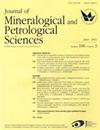Carbon dioxide and water in the crust. Part 2: Solubility in silicate melts
IF 1
4区 地球科学
Q4 MINERALOGY
引用次数: 0
Abstract
The solubility of H2O and CO2 in silicate melts is crucial in understanding the geological phenomena occurring in a fluid–melt system. Although several recent solubility models are used in petrological studies, the model of Duan (2014) has rarely been used and has been evaluated less thoroughly, despite its potentially high applicability, mainly because calculation software is unavailable. This paper reviews the Duan (2014) solubility model and its calculation procedure for H2O–CO2 solubility. It was found that the Duan (2014) model uses a special protocol to calculate the fluid partial fugacity coefficient, for which no explanation is given in the original paper, thereby limiting the general use of the model. Therefore, I present an appropriate calculation procedure and provide a C-language code for convenience. The predictability of the model was evaluated by comparison with experimental solubility data. It was shown that the Duan (2014) model reproduces well the data for rhyolitic melts, whereas predictability is somewhat weak for other melts, including dacitic, andesitic, and basaltic melts. Caution is thus required when applying the Duan (2014) model to SiO2-poor melts.地壳中的二氧化碳和水。第2部分:在硅酸盐熔体中的溶解度
H2O和CO2在硅酸盐熔体中的溶解度对于理解流体-熔体系统中发生的地质现象至关重要。尽管最近的几种溶解度模型被用于岩石学研究,但Duan(2014)的模型很少被使用,而且评估不太彻底,尽管其潜在的高适用性,主要是因为没有计算软件。本文回顾了Duan(2014)溶解度模型及其H2O-CO2溶解度的计算过程。我们发现,Duan(2014)模型使用了一种特殊的协议来计算流体部分逸度系数,而在原论文中没有给出解释,从而限制了模型的一般使用。因此,我给出了相应的计算过程,并提供了c语言代码,以方便使用。通过与实验溶解度数据的比较,评价了模型的可预测性。研究表明,Duan(2014)模型很好地再现了流纹岩熔体的数据,而对其他熔体(包括英安岩、安山岩和玄武岩熔体)的可预测性有些弱。因此,在将Duan(2014)模型应用于缺乏sio2的熔体时需要谨慎。
本文章由计算机程序翻译,如有差异,请以英文原文为准。
求助全文
约1分钟内获得全文
求助全文
来源期刊
CiteScore
1.80
自引率
14.30%
发文量
5
审稿时长
>12 weeks
期刊介绍:
The Journal of Mineralogical and Petrological Sciences (JMPS) publishes original articles, reviews and letters in the fields of mineralogy, petrology, economic geology, geochemistry, planetary materials science, and related scientific fields. As an international journal, we aim to provide worldwide diffusion for the results of research in Japan, as well as to serve as a medium with high impact factor for the global scientific communication
Given the remarkable rate at which publications have been expanding to include several fields, including planetary and earth sciences, materials science, and instrumental analysis technology, the journal aims to encourage and develop a variety of such new interdisciplinary scientific fields, to encourage the wide scope of such new fields to bloom in the future, and to contribute to the rapidly growing international scientific community.
To cope with this emerging scientific environment, in April 2000 the journal''s two parent societies, MSJ* (The Mineralogical Society of Japan) and JAMPEG* (The Japanese Association of Mineralogists, Petrologists and Economic Geologists), combined their respective journals (the Mineralogical Journal and the Journal of Mineralogy, Petrology and Economic Geology). The result of this merger was the Journal of Mineralogical and Petrological Sciences, which has a greatly expanded and enriched scope compared to its predecessors.

 求助内容:
求助内容: 应助结果提醒方式:
应助结果提醒方式:


